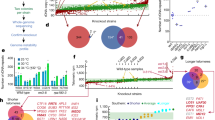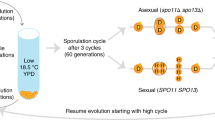Abstract
IT is puzzling that mutants are isolated at a similar frequency in tissue cultures of haploid and diploid strains1–3, for twice as many mutations have often been assumed necessary to produce a mutant diploid as to produce a mutant haploid. Explanations for the apparent high frequency of mutation in diploids1–6 include epigenetic effects1–3, changes in gene dose7, dominant mutations8, recessive X-linked mutations4 and heterozygosity before selection9. Most recessive autosomal mutants are assumed to arise because of haploidy for the chromosome containing the mutant locus, since most cell cultures are aneuploid4,10,11. It is difficult to measure the mutation frequency at recessive loci in cultured haploid and diploid strains because of the paucity of haploid strains and the problems caused by aneuploidy. The slime mould Dictyostelium discoideum, a simple eukaryote, is suitable for this purpose, however, as both haploid and diploid strains are available12–14 and aneuploids are so unstable or inviable that none has been isolated14. Using this organism, I have found, contrary to the expectation that mutant diploids should be extremely rare (say 2 × 10−12 diploid, 10−6 haploid )1–6, that the difference in mutation frequency between haploids and diploids for one recessive locus is only an order of magnitude.
This is a preview of subscription content, access via your institution
Access options
Subscribe to this journal
Receive 51 print issues and online access
$199.00 per year
only $3.90 per issue
Buy this article
- Purchase on Springer Link
- Instant access to full article PDF
Prices may be subject to local taxes which are calculated during checkout
Similar content being viewed by others
References
Harris, M., J. cell. Physiol., 78, 177–184 (1971).
Mezger-Freed, L., J. Cell Biol., 51, 742–751 (1971).
Mezger-Freed, L., Nature new Biol., 235, 245–246 (1972).
Chu, E. H. Y., Genetics, 78, 115–132 (1974).
Terzi, M., Genetics and the Animal Cell (Wiley, London and New York, 1974).
Thompson, L. H., and Baker, R. M., in Methods in Cell Biology, 6 (edit. by Prescott, D. M.), 209–281 (Academic, New York, 1973).
Terzi, M., Proc. natn. Acad. Sci. U.S.A., 71, 5027–5031 (1974).
Baker, R. M., et al., Cell, 1, 9–21 (1974).
Rappaport, H., and DeMars, R., Genetics, 75, 335–345 (1973).
Chasin, L. A., and Urlab, G., Science, 187, 1091–1093 (1975).
Caboche, M., Genetics, 77, 309–322 (1974).
Ross, I. K., Am. J. Bot., 47, 54–59 (1960).
Katz, E. R., and Sussman, M., Proc. natn. Acad. Sci. U.S.A., 69, 495–498 (1972).
Brody, T., and Williams, K. L., J. gen. Microbiol., 82, 371–383 (1974).
Williams, K. L., Kessin, R. H., and Newell, P. C., J. gen. Microbiol., 84, 59–69 (1974).
Rothman, F. G., and Alexander, E. T., Genetics, 80, 715–731 (1975).
Mosses, D., Williams, K. L., and Newell, P. C., J. gen. Microbiol., 90, 247–259 (1975).
Katz, E. R., and Kao, V., Proc. natn. Acad. Sci. U.S.A., 71, 4025–4026 (1974).
Jain, H. K., Raut, R. N., and Khamankar, Y. G., Heredity, 23, 247–256 (1968).
Author information
Authors and Affiliations
Rights and permissions
About this article
Cite this article
WILLIAMS, K. Mutation frequency at a recessive locus in haploid and diploid strains of a slime mould. Nature 260, 785–786 (1976). https://doi.org/10.1038/260785a0
Received:
Accepted:
Published:
Issue Date:
DOI: https://doi.org/10.1038/260785a0
This article is cited by
Comments
By submitting a comment you agree to abide by our Terms and Community Guidelines. If you find something abusive or that does not comply with our terms or guidelines please flag it as inappropriate.



